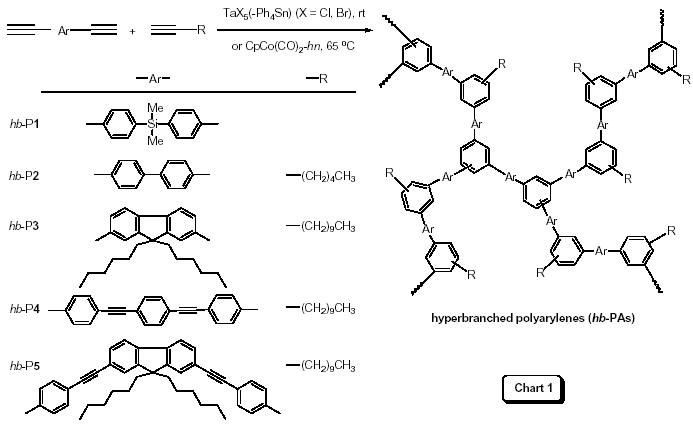Hongchen Dong, Matthias Häußler, and Ben Zhong Tang*
Department of Chemistry and Center for Display Research, The Hong Kong
University of Science & Technology, Clear Water Bay, Kowloon, Hong Kong, China;
E-mail: tangbenz@ust.hk
Abstract : π-Conjugated polymers are of much current academic and significant technological interest due to their many potential optical and electronic applications [1]. The frontier of conjugated polymer research is moving from linear to dendritic or hyperbranched structures [2–3]. In this work, a number of hyperbranched polyarylenes (hb-PAs) are synthesized by transition metal-catalyzed polycyclotrimerizations of aromatic diynes. This kind of [2 + 2 + 2] polycycloaddition reaction is carried out smoothly with one-pot, single-step procedure, giving soluble hb-PAs of high molecular weights (Mw up to ~2 × 105) in high isolation yields (up to ~100%). Chart 1 gives some examples of hb-PAs with varying aromatic rings and functional groups [4].

All the hb-PAs exhibit excellent thermal stability, losing little of their weights when heated to >400 °C. For instance, as can be seen from Figure 1 , hb-P2 loses merely 5% of its weight at a temperature as high as 595 °C, while hb-P1 graphitizes when pyrolyzed at 800 °C in a yields as high as 86%.
The molecular structures of the polymers are unique in that the “new” benzene rings formed by the cyclotrimerization and the “old” aromatic moieties from the monomers are interconnected. This kind of conjugated molecular structure enhances the electronic communications in the hb-PAs and endows them with efficient light-emitting and excellent optical-limiting properties.
Upon photoexcitation, the hb-PAs emit strong deep-blue and blue-green lights. The emission intensity of hyperbranched poly(2,7-ethynylfluorene-co-1-dodecyne) is clearly higher than that of poly(1-phenyl-1-octyne), a well-known luminescent disubstituted polyacetylene [5]. Its emission is very efficient, with a fluorescence quantum yields up to 98%.

The hb-PAs are aromatic macromolecules and may serve as good optical limiters [6]. As shown in Figure 2 , the hb-PAs effectively attenuate the power of intense 532 nm laser pulses. Their optical limiting threshold (FL) and signal suppression (Ft,m/Fi,m) are superior to those of C60, a well-known optical limiter [7]. In addition, the optical limiting performance of hb-PAs is sensitive to a change in its molecular structure, offering the opportunity to tune its optical limiting properties through molecular engineering endeavors.